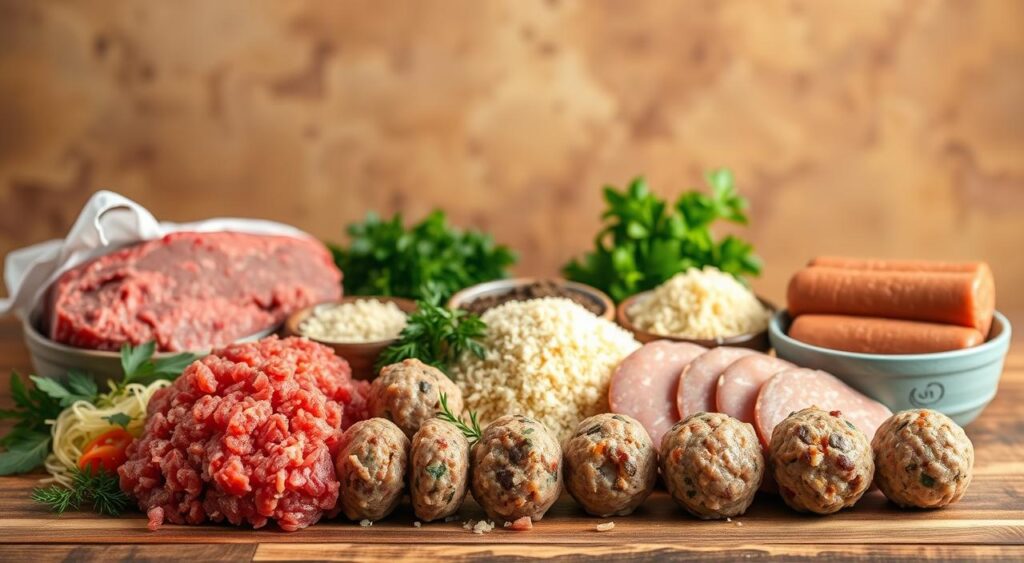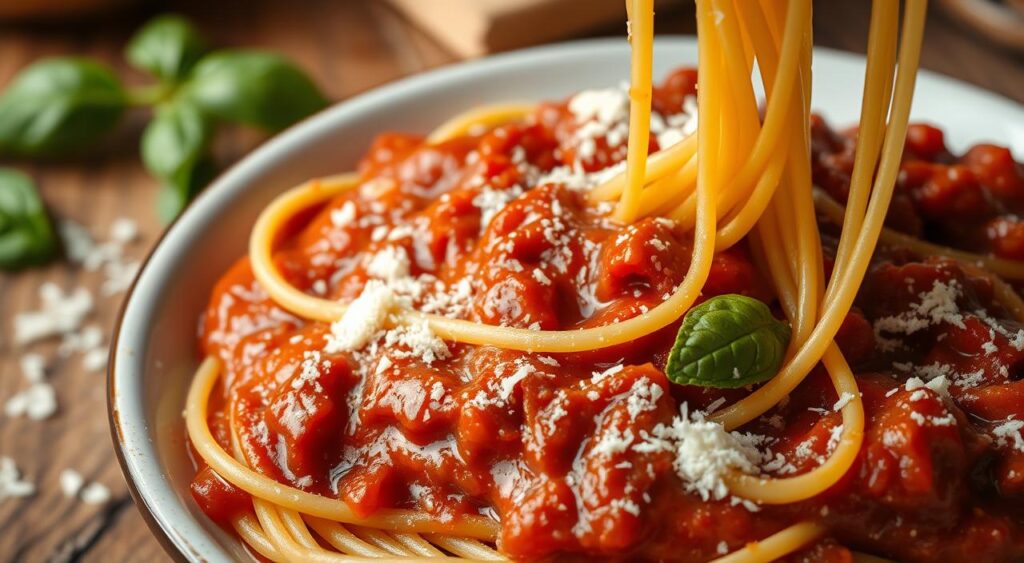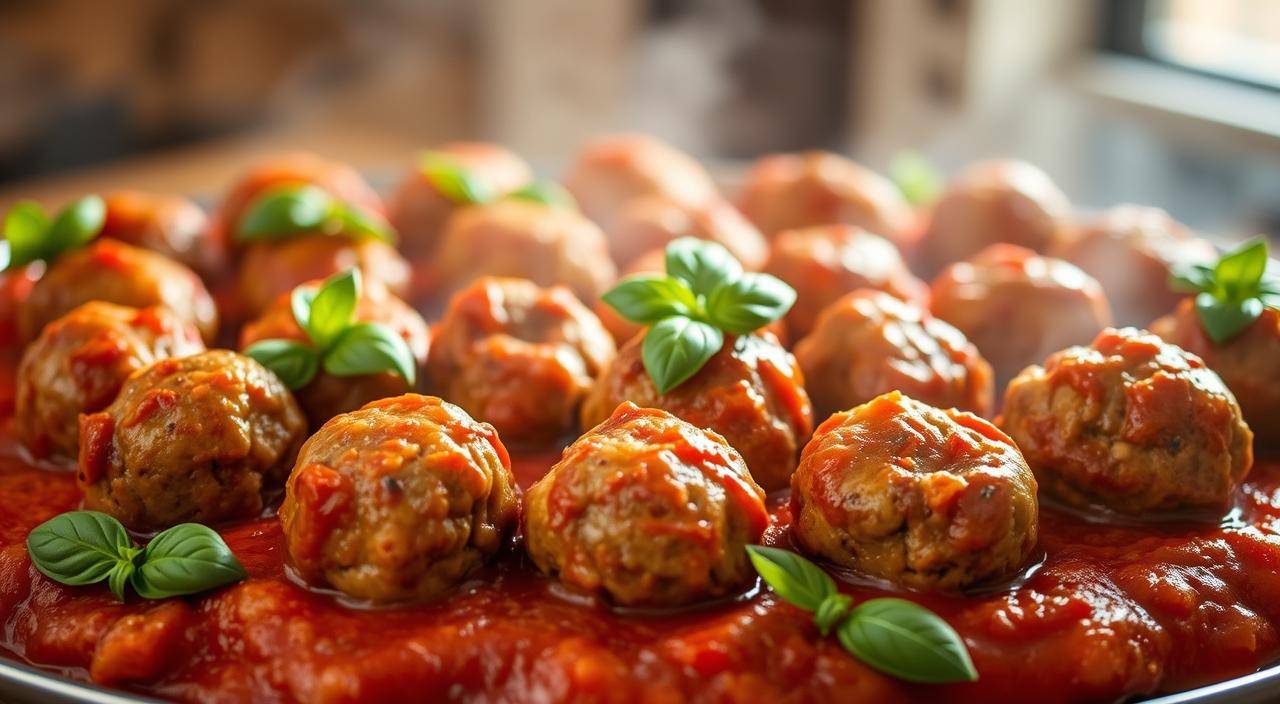There’s something special about a Italian meatballs recipe that feels like home. Maybe it’s the rich aroma of tomato sauce bubbling on the stove or that first bite of a perfectly tender meatball—it’s the kind of dish that brings back comforting memories and carries a sense of tradition.
What sets this Meatball Recipe apart is its thoughtful blend of flavors and techniques. A combination of ground meats, fresh herbs, and a secret panade method keeps the meatballs juicy and full of flavor. Broiling adds a satisfying crispness, while a slow simmer in savory tomato sauce infuses them with a deep, rich taste.
Whether you’re cooking for a weeknight dinner or a special gathering, this Meatball Recipe delivers a heartwarming, unforgettable meal. Let’s walk through the steps to bring this classic comfort food to life.
Table of Contents
Gathering Ingredients and Must-Have Kitchen Tools
Crafting the perfect dish starts with the right ingredients and tools. The quality of your components and the efficiency of your equipment can make or break the final result. Let’s explore what you’ll need to create a dish that’s both flavorful and satisfying.
Essential Ingredients for Flavor and Texture
When it comes to crafting a truly unforgettable meatball recipe, the quality and balance of your ingredients make all the difference. At the heart of any great meatball is high-quality ground beef—ideally an 80-85% lean blend. This specific fat ratio ensures that your meatballs stay juicy and flavorful without becoming overly greasy during cooking.
To deepen the flavor profile, freshly grated Parmesan cheese is a must. It brings a salty, umami richness that complements the beef perfectly. Italian-seasoned breadcrumbs do more than just hold the mixture together—they contribute to the texture, giving the meatballs a light, tender bite rather than a dense, heavy feel.
A good meatball recipe also leans heavily on aromatics. Finely grated onion and garlic, preferably done with a microplane, are distributed evenly throughout the mixture, ensuring every bite is packed with bold, savory notes. These small additions make a big impact on the overall flavor.
Finally, don’t underestimate the role of eggs and milk. They act as the binding agents, holding the meat, cheese, and breadcrumbs together while maintaining a soft, cohesive consistency. This combination is key to achieving meatballs that are tender on the inside and golden on the outside.
Recommended Equipment for Effortless Cooking
Having the right tools can save you time and effort. A large mixing bowl is essential for combining ingredients evenly. A cookie scoop ensures uniform portioning, while a microplane grater finely processes garlic and onion for maximum flavor.
For baking, a sturdy baking sheet lined with parchment paper prevents sticking and ensures even browning. A skillet is optional for those who prefer stovetop cooking, but either method delivers delicious results.
“The right tools and ingredients transform cooking from a chore into a joy.”
| Ingredient | Cost |
|---|---|
| Ground Beef (1 lb) | $4.98 |
| Parmesan (1/2 cup) | $1.92 |
| Italian-Seasoned Breadcrumbs (1/2 cup) | $0.17 |
| Garlic Powder (1/2 tsp) | $0.05 |
| Eggs (2 large) | $1.58 |
Mastering the Italian meatballs recipe
The secret to creating a dish that’s both tender and flavorful lies in the details. Understanding the balance of ingredients and their roles is crucial for achieving the perfect texture and taste. Let’s break down the essentials to help you master this timeless dish.
The Perfect Meat and Breadcrumb Ratio
Getting the right ratio of meat to breadcrumbs is the foundation of a great dish. For every pound of meat, use about half a cup of breadcrumbs. This ensures the mixture holds together without becoming dense. Adding one egg acts as a binder, keeping everything cohesive while cooking.
The panade method, where breadcrumbs are soaked in milk, is a game-changer. It traps moisture, ensuring every bite is juicy and tender. This technique has been passed down through generations for a reason—it works.
Role of Eggs, Cheese, and Aromatics
Eggs are more than just binders—they add richness to the mixture. Freshly grated cheese, like parmesan, enhances both flavor and texture. Its savory notes complement the meat perfectly, while also helping to bind the ingredients.
Aromatics like garlic and onion are essential for depth of flavor. Finely mince or grate them to distribute their taste evenly. These ingredients, when combined with the right techniques, create a dish that’s both comforting and unforgettable.
“The right balance of ingredients transforms a simple dish into a masterpiece.”
| Ingredient | Role |
|---|---|
| Eggs | Binder and richness |
| Cheese | Flavor and texture enhancer |
| Garlic | Adds depth of flavor |
| Breadcrumbs | Provides structure and moisture |
Building the Ideal Meatball Mixture
The key to a tender and juicy result lies in how you mix the ingredients. A well-crafted mixture ensures every bite is moist and flavorful. Let’s explore the techniques that make this possible.
Mixing Techniques to Maintain Juiciness
Start by gently folding the ingredients together. Overmixing can make the mixture dense and tough. Use your hands to combine everything evenly without pressing too hard.
Add the egg and salt at the right stages. The egg acts as a binder, while the salt enhances flavor. Mixing them in gradually helps create a uniform texture.
Incorporate oil and aromatics carefully. Olive oil adds richness, but too much can deflate the mixture. A shallow pan is ideal for controlling temperature and consistency.
Remember, the goal is to keep the mixture airy. This ensures each ball stays tender and juicy during cooking. Take your time and mix with care for the best results.
Shaping and Browning for Optimal Texture
Achieving the perfect texture starts with how you shape and cook your dish. The techniques you use can make a significant difference in the final result. Let’s explore the best methods to ensure your creation is both tender and flavorful.
Hand-Shaping Versus Using a Cookie Scoop
Shaping by hand allows for a personal touch, but it can lead to uneven sizes. Using a cookie scoop ensures consistency, which is key for even cooking. Both methods have their merits, so choose based on your preference.
A large bowl is essential for keeping your workspace organized. It helps you mix and shape efficiently, ensuring a smooth workflow. Whether you’re working with beef, pork, or a blend, the right tools make the process easier.
Broiling, Baking, and the Maillard Reaction
Browning on one side at a time creates a crispy crust that enhances both texture and flavor. This process activates the Maillard reaction, a chemical reaction that develops rich, complex tastes on the surface.
Broiling or baking are excellent methods for achieving this effect. Broiling works quickly, while baking offers more control. Both techniques ensure your dish has a golden, appetizing exterior.
“The Maillard reaction is the secret behind the irresistible aroma and taste of perfectly browned food.”
- Use a large bowl to keep your mixture organized.
- Shape consistently for even cooking and browning.
- Broil or bake to activate the Maillard reaction for rich flavor.
- Experiment with meat blends like pork for a customized taste.
Simmering in Rich Tomato Sauce for Depth of Flavor
The final step to creating a memorable dish lies in the sauce. A well-crafted marinara sauce not only enhances the flavor but also ensures every bite is tender and juicy. Let’s dive into the process of making a homemade sauce that perfectly complements your creation.
Creating Homemade Marinara Sauce
Start with high-quality crushed San Marzano tomatoes. These tomatoes are known for their sweetness and low acidity, making them ideal for a rich marinara sauce. Add tomato paste for depth and a touch of olive oil for richness.
Simmer the sauce to allow the flavors to meld. This process also helps thicken the sauce, giving it the perfect texture to cling to spaghetti or any pasta of your choice. Stir occasionally to prevent sticking and ensure even cooking.
Infusing Herbs and Spices for Extra Flavor
Fresh basil, oregano, and garlic are essential for a flavorful marinara sauce. Add these ingredients early in the simmering process to allow their flavors to infuse fully. A pinch of red pepper flakes can add a subtle kick if desired.
Follow these simple instructions to achieve the best results:
- Combine crushed tomatoes, tomato paste, and olive oil in a large pot.
- Add finely chopped garlic, basil, and oregano.
- Simmer on low heat for 30-45 minutes, stirring occasionally.
- Adjust seasoning with salt and pepper to taste.
Reducing the sauce intensifies its flavor, making it the perfect companion to serve meatball dishes. The slow simmer also tenderizes the meat, ensuring a melt-in-your-mouth texture.
| Ingredient | Role |
|---|---|
| Crushed San Marzano Tomatoes | Base for sweetness and richness |
| Tomato Paste | Adds depth and thickness |
| Fresh Basil | Infuses aromatic flavor |
| Garlic | Enhances savory notes |
“A great sauce is the heart of any dish, bringing together all the elements in perfect harmony.”
Variations and Customizations for Your Meatballs
Customizing your dish allows you to explore endless flavor possibilities. Whether you’re catering to dietary restrictions or simply experimenting with new tastes, there are countless ways to adapt this classic dish to suit your preferences.
Alternative Meat Blends and Cheese Options
Using a mix of meats can add depth and richness to your dish. A blend of ground beef, pork, and veal creates a traditional flavor profile. For a lighter option, try ground turkey or chicken. Each meat brings its unique texture and taste to the table.
Cheese is another versatile ingredient. While parmesan is a classic choice, pecorino Romano offers a sharper, saltier flavor. You can also mix cheeses for a more complex taste. Experiment with different combinations to find your favorite.

Gluten-Free and Dairy-Free Adaptations
For those with dietary restrictions, simple substitutions can make this dish accessible. Use gluten-free breadcrumbs or crushed rice crackers to maintain the texture without gluten. Dairy-free cheese alternatives, like nutritional yeast, can replace traditional cheese for a similar savory flavor.
Adjusting the tomato sauce is also key. Ensure it’s free from dairy or gluten-containing additives. Homemade sauce allows you to control the ingredients and tailor it to your needs.
| Ingredient | Substitution |
|---|---|
| Ground Beef | Ground Turkey or Chicken |
| Parmesan Cheese | Pecorino Romano or Nutritional Yeast |
| Breadcrumbs | Gluten-Free Breadcrumbs or Rice Crackers |
| Tomato Sauce | Homemade Dairy-Free Sauce |
“Adapting recipes to suit your needs ensures everyone can enjoy a delicious meal.”
Time-Saving Techniques and Batch Cooking Tips
Preparing meals in advance can transform your weeknight dinners into stress-free experiences. Whether you’re cooking for a crowd or just stocking up for the week, these strategies will help you save time and effort while keeping your dishes fresh and flavorful.
Freezing, Reheating, and Meal Prep Strategies
Freezing is a great way to preserve your creations for future meals. For uncooked portions, shape them into balls and place them on a baking sheet. Freeze until solid, then transfer to an airtight container. This prevents sticking and makes it easy to grab only what you need.
For cooked dishes, let them cool completely before freezing. Use freezer-safe bags or containers to lock in freshness. Label each container with the date to keep track of storage times. Properly stored, they can last up to three months in the freezer.
Reheating is just as important as freezing. For best results, thaw frozen portions in the refrigerator overnight. Reheat in the oven at 350°F for 15-20 minutes or in a slow cooker on low for 2-3 hours. This ensures they stay moist and retain their original texture.
- Cool portions completely before freezing to prevent ice crystals.
- Use airtight containers or freezer bags to maintain freshness.
- Label containers with dates to track storage times.
- Reheat in the oven or slow cooker for optimal texture.
Incorporating ingredients like olive oil and milk into your mixture helps retain moisture during freezing and reheating. These small details make a big difference in the final result.
“Batch cooking not only saves time but also ensures you always have a delicious meal ready to go.”
By following these tips, you can enjoy the convenience of meal prep without sacrificing flavor or quality. Whether you’re cooking for one or feeding a family, these strategies will make your kitchen life easier and more efficient.
Serving Suggestions to Elevate Your Dish
Transform your meal into a culinary masterpiece with these serving ideas. Whether you’re hosting a casual dinner or a special occasion, the right pairings and presentation can make all the difference. Let’s explore how to create a well-balanced plate that delights your taste buds.
Perfect Pairings with Pasta, Subs, and Sides
For a classic combination, serve your dish with spaghetti and a rich marinara sauce. The sauce’s sweetness complements the savory flavors perfectly. If you’re in the mood for something handheld, try a meatball sub. Use a fresh baguette and layer it with sauce, cheese, and a sprinkle of pepper for extra zest.
Don’t forget the sides! Garlic bread adds a crispy, buttery contrast, while a mixed salad brings freshness to the meal. Roasted vegetables or mashed potatoes are also excellent choices for a heartier option.

Garnishing Tips for an Appetizing Presentation
Garnishes can elevate your dish both visually and flavor-wise. Fresh basil leaves add a pop of color and a hint of sweetness. A drizzle of olive oil enhances richness, while freshly grated Parmesan cheese provides a savory finish.
For a touch of heat, sprinkle red pepper flakes on top. These small details make your dish look as good as it tastes, impressing your guests and enhancing the dining experience.
| Pairing | Garnish |
|---|---|
| Spaghetti | Fresh basil, parmesan |
| Meatball Sub | Olive oil, pepper flakes |
| Garlic Bread | Parsley, butter |
| Mixed Salad | Olive oil, lemon zest |
“The right pairing and garnish can turn a simple dish into a memorable feast.”
Conclusion
The art of cooking lies in balancing tradition and creativity. By focusing on the right ingredient ratios and techniques, you can create a dish that’s both tender and flavorful. Fresh onion and parmesan cheese add depth, while mixing by hand ensures a perfect texture.
Remember, quality ingredients and proper cooking heat are key. Whether you stick to tradition or explore variations, the process is yours to master. Serve with pride and share your results to celebrate this timeless dish.
FAQ
1. What are Italian meatballs made of?
Italian meatballs typically include a mixture of ground beef, pork, or veal, along with breadcrumbs, Parmesan cheese, eggs, garlic, parsley, and various seasonings. The meatballs are often simmered in marinara sauce for added flavor.
2. Can I make Italian meatballs with ground turkey or chicken?
Yes! Ground turkey or chicken can be used as a healthier alternative to beef or pork. You may need to adjust the seasoning to ensure they remain flavorful.
3. How do you keep Italian meatballs moist?
To keep meatballs moist, use a mixture of meat with some fat, add breadcrumbs soaked in milk, and avoid overcooking. Simmering the meatballs in sauce also helps retain moisture.
4. Should I fry or bake Italian meatballs?
Both methods are valid. Frying gives the meatballs a crisp exterior, while baking is a healthier option and reduces the amount of oil used. Some people bake and then simmer in sauce for the best of both worlds.
5. Can I freeze Italian meatballs?
Yes, Italian meatballs can be frozen both before and after cooking. If freezing uncooked, arrange them on a baking sheet to freeze individually, then transfer to a bag. Cooked meatballs can be frozen in sauce for convenience.
6. How long should I cook Italian meatballs?
Italian meatballs usually need about 20-30 minutes of cooking in a simmering marinara sauce or 15-20 minutes in a 375°F (190°C) oven if baked. Ensure they reach an internal temperature of 165°F (74°C).
7. What should I serve with Italian meatballs?
Italian meatballs can be served with spaghetti, on a sub roll for a meatball sandwich, with a side of garlic bread, or even as an appetizer with a dipping sauce.
8. Can I use store-bought marinara sauce for Italian meatballs?
Yes, store-bought marinara sauce can be used for convenience. However, making your own sauce from scratch can add more depth of flavor.
9. Are Italian meatballs gluten-free?
Traditional Italian meatballs contain breadcrumbs, which have gluten. To make them gluten-free, you can use gluten-free breadcrumbs or substitute with rice or ground oats.
10. How do I make Italian meatballs spicy?
To add spice, include crushed red pepper flakes or a diced jalapeño to the meatball mixture or sauce. Adjust according to your spice tolerance.
If you’re working on a blog or video about Italian meatballs, you can use some of these questions to engage your audience and provide helpful answers!

